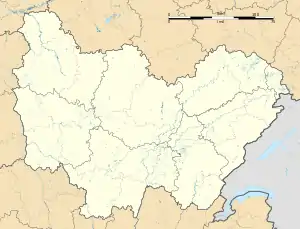Semur-en-Auxois
Semur-en-Auxois (French pronunciation: [səmyʁ ɑ̃.n‿o(k)swa]) is a commune of the Côte-d'Or department in eastern France. The politician François Patriat, the engineers Edmé Régnier L'Aîné (1751–1825) and Émile Dorand (1866-1922), and the Encyclopédiste Philippe Guéneau de Montbeillard (1720–1785) were born in Semur-en-Auxois, while the military engineer Vauban (1633–1707) was educated at the Carmelite college.
Semur-en-Auxois | |
|---|---|
 The Pinard Bridge in Semur-en-Auxois | |
 Coat of arms | |
Location of Semur-en-Auxois | |
 Semur-en-Auxois  Semur-en-Auxois | |
| Coordinates: 47°29′29″N 4°20′01″E | |
| Country | France |
| Region | Bourgogne-Franche-Comté |
| Department | Côte-d'Or |
| Arrondissement | Montbard |
| Canton | Semur-en-Auxois |
| Government | |
| • Mayor (2020–2026) | Catherine Sadon[1] |
| Area 1 | 19.14 km2 (7.39 sq mi) |
| Population | 4,114 |
| • Density | 210/km2 (560/sq mi) |
| Time zone | UTC+01:00 (CET) |
| • Summer (DST) | UTC+02:00 (CEST) |
| INSEE/Postal code | 21603 /21140 |
| Elevation | 237–423 m (778–1,388 ft) (avg. 286 m or 938 ft) |
| 1 French Land Register data, which excludes lakes, ponds, glaciers > 1 km2 (0.386 sq mi or 247 acres) and river estuaries. | |
Semur-en-Auxois has a medieval core, built on a pink granite bluff more than half-encircled by the River Armançon. The river formerly provided motive power for tanneries and mills, but its flow is now somewhat reduced by the Lac de Pont. The dam was built upstream in the 19th century to provide water for the Canal de Bourgogne.
Sport
Semur-en-Auxois was the start of Stage 6 in the 2007 Tour de France.
Population
|
| ||||||||||||||||||||||||||||||||||||||||||||||||||||||||||||||||||||||||||||||||||||||||||||||||||||||||||||
| Source: EHESS[3] and INSEE (1968-2017)[4] | |||||||||||||||||||||||||||||||||||||||||||||||||||||||||||||||||||||||||||||||||||||||||||||||||||||||||||||
Sights


- The church, La Collégiale Notre-Dame, was founded in 1225 and built in flamboyant Gothic style. It was restored in the 19th century by Viollet-le-Duc. The north tympanum depicts the legend of St. Thomas.
- La porte Sauvigny, built in the 15th century, marks the entrance to the city
- The fortified castle, built in the 13th century and dismantled in the 17th century. Parts visible today are:
- La tour de l'Orle d'Or, with a height of 44 metres and walls 5 metres thick
- La tour de la Gehenne
- La tour de la Prison
- La tour Margot, behind the theatre.
- Bridges of the city crossing the Armançon:
- Le pont Joly, which provides a picturesque view of the city
- Le pont Pinard
- Le pont des Minimes
- The ramparts provide a promenade with views of the river
See also
- The Sinemurian Age of the Jurassic Period of geological time is named for Semur-en-Auxois
- Communes of the Côte-d'Or department
References
- "Répertoire national des élus: les maires" (in French). data.gouv.fr, Plateforme ouverte des données publiques françaises. 13 September 2022.
- "Populations légales 2020". The National Institute of Statistics and Economic Studies. 29 December 2022.
- Des villages de Cassini aux communes d'aujourd'hui: Commune data sheet Semur-en-Auxois, EHESS (in French).
- Population en historique depuis 1968, INSEE